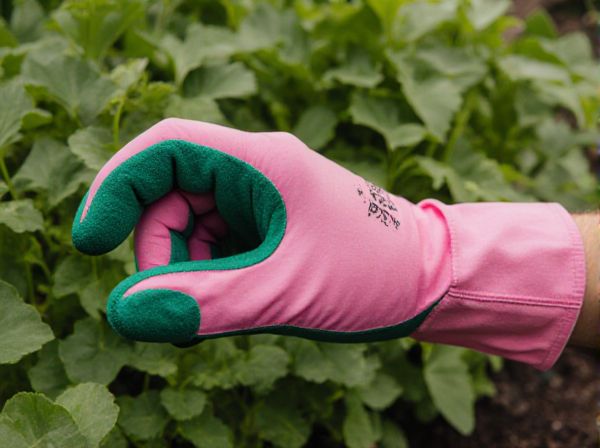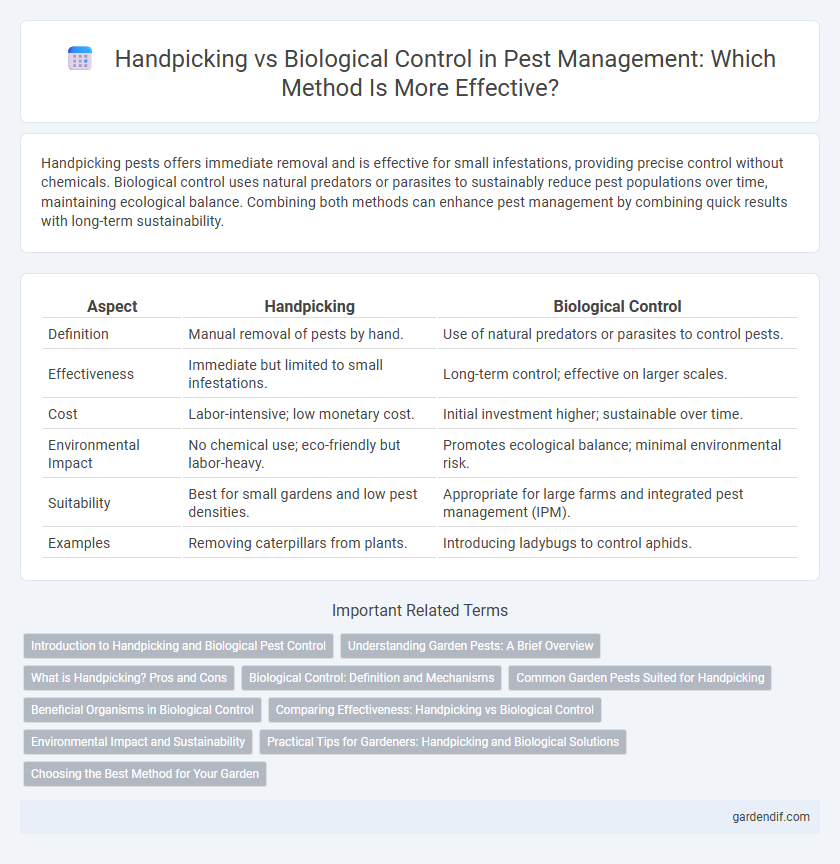
Handpicking vs biological control Illustration
Handpicking pests offers immediate removal and is effective for small infestations, providing precise control without chemicals. Biological control uses natural predators or parasites to sustainably reduce pest populations over time, maintaining ecological balance. Combining both methods can enhance pest management by combining quick results with long-term sustainability.
Table of Comparison
| Aspect | Handpicking | Biological Control |
|---|---|---|
| Definition | Manual removal of pests by hand. | Use of natural predators or parasites to control pests. |
| Effectiveness | Immediate but limited to small infestations. | Long-term control; effective on larger scales. |
| Cost | Labor-intensive; low monetary cost. | Initial investment higher; sustainable over time. |
| Environmental Impact | No chemical use; eco-friendly but labor-heavy. | Promotes ecological balance; minimal environmental risk. |
| Suitability | Best for small gardens and low pest densities. | Appropriate for large farms and integrated pest management (IPM). |
| Examples | Removing caterpillars from plants. | Introducing ladybugs to control aphids. |
Introduction to Handpicking and Biological Pest Control
Handpicking involves manually removing pests from plants, providing an immediate and chemical-free method for pest management especially in small gardens or delicate crops. Biological pest control utilizes natural enemies such as predatory insects, parasitoids, and pathogens to reduce pest populations sustainably and minimize environmental impact. Combining these approaches enhances pest control effectiveness by integrating direct physical removal with ecosystem-based regulation.
Understanding Garden Pests: A Brief Overview
Handpicking pests offers a direct and immediate method to reduce garden pest populations by physically removing harmful insects like caterpillars and beetles. Biological control leverages natural predators, such as ladybugs and parasitic wasps, to maintain ecological balance and sustainably manage pest infestations. Understanding garden pests involves recognizing specific insect species, their life cycles, and behavior to choose the most effective pest management strategy.
What is Handpicking? Pros and Cons
Handpicking is a manual pest control method where pests like caterpillars, beetles, or aphids are physically removed from plants by hand. This technique offers the advantage of being chemical-free and environmentally safe, allowing precise targeting without harming beneficial insects. However, handpicking is labor-intensive, impractical for large infestations, and less effective against tiny or hidden pests compared to biological control methods that utilize natural predators or parasites.
Biological Control: Definition and Mechanisms
Biological control involves the use of natural predators, parasites, or pathogens to manage pest populations, reducing reliance on chemical pesticides. This method exploits ecological interactions, such as predation, parasitism, and competition, to maintain pest populations below damaging levels. Effective biological control agents include lady beetles, parasitic wasps, and entomopathogenic fungi, which target specific pests, promoting sustainable and environmentally friendly pest management.
Common Garden Pests Suited for Handpicking
Common garden pests suited for handpicking include aphids, caterpillars, Japanese beetles, and squash bugs, which are often visible and accessible on plants. This manual pest control method reduces chemical use and targets individual pests effectively, minimizing harm to beneficial insects. Handpicking complements biological control by immediately removing pests, enhancing overall pest management strategies in organic and sustainable gardening.
Beneficial Organisms in Biological Control
Beneficial organisms in biological control, such as predatory insects, parasitoids, and microbial agents, play a crucial role in managing pest populations by naturally suppressing harmful species. Unlike handpicking, which is labor-intensive and limited to visible pests, biological control harnesses ecological interactions to provide sustainable and long-term pest management. The use of these beneficial organisms reduces chemical pesticide reliance, promoting environmental health and crop resilience.
Comparing Effectiveness: Handpicking vs Biological Control
Handpicking pests offers immediate removal and precise targeting, making it effective for small-scale infestations but is labor-intensive and less practical for large areas. Biological control utilizes natural predators or pathogens to sustainably reduce pest populations, providing long-term pest suppression but may take longer to achieve noticeable results. Effectiveness depends on pest type, infestation scale, and environment, with biological control favored for ecological balance and handpicking suited for quick, small-scale interventions.
Environmental Impact and Sustainability
Handpicking pests offers a chemical-free method that minimizes environmental contamination and preserves beneficial insect populations, promoting sustainable agriculture. Biological control introduces natural predators or parasites to manage pest populations, reducing reliance on synthetic pesticides and enhancing ecosystem balance. Both approaches support long-term sustainability by maintaining soil health and biodiversity while effectively suppressing pest outbreaks.
Practical Tips for Gardeners: Handpicking and Biological Solutions
Handpicking pests such as aphids, caterpillars, and beetles remains an effective, chemical-free method for gardeners to control infestations on vegetables and ornamental plants. Introducing biological control agents like ladybugs, lacewings, and parasitic wasps helps naturally reduce pest populations and maintain garden ecosystem balance. Combining manual removal with beneficial insects maximizes pest management efficiency while minimizing damage to desirable plants and beneficial species.
Choosing the Best Method for Your Garden
Handpicking pests offers precise, chemical-free control ideal for small gardens or targeted infestations, while biological control utilizes natural predators to maintain ecological balance over larger areas. Evaluating pest type, garden size, and environmental impact helps determine whether manual removal or introducing beneficial organisms is more effective. Integrating both methods can optimize pest management, enhancing plant health and sustainability in your garden.
Handpicking vs biological control Infographic

 gardendif.com
gardendif.com